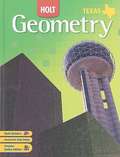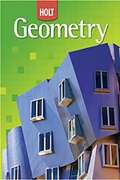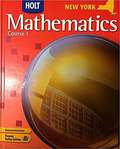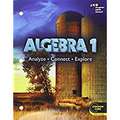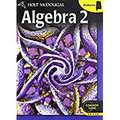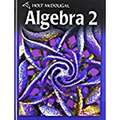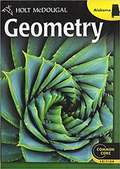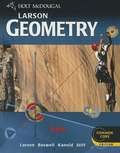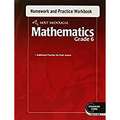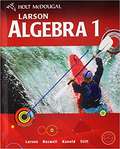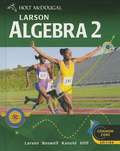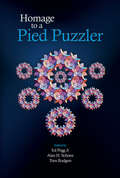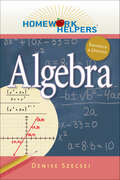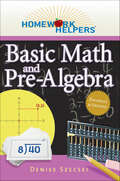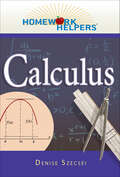- Table View
- List View
Holt Geometry
by Winston Holt RinehartHolt Geometry provides foundation concepts for high school mathematics. As presented in grades k-8, the basic understandings of number, operation, and quantitative reasoning; patterns, relationships, and algebraic thinking; geometry; measurement; and probability and statistics are essential foundations for all work in high school mathematics.
Holt Mathematics Course 1, New York
by David J. Chard Edward B. Burger Jennie M. BennettNIMAC-sourced textbook
Holt McDougal Algebra 1: Analyze-Connect -Explore
by Timothy D. Kanold Edward B. Burger Juli K. Dixon Steven J. Leinwand Matthew R. Larson Martha E. Sandoval-MartinezThis book covers important topics of Algebra in detail with focus on interactive student exercises.
Holt McDougal Algebra 2
by Holt McDougalThe chapters of Algebra 2 include: Foundations for Functions, Linear Functions, Linear Systems, Matrices, Quadratic Functions, Polynomial Functions, Exponential and Logarithmic Functions, Rational and Radical Functions, Properties and Attributes of Functions, Conic Sections, Probability and Statistics, Sequences and Series, Trigonometric Functions, and Trigonometric Graphs and Identities.
Holt McDougal Geometry (Alabama)
by David J. Chard Edward B. Burger Paul A. KennedyNIMAC-sourced textbook
Holt McDougal Geometry Alabama (Cengage Advantage Books #2013)
by Holt McdougalStudent Edition of Holt McDougal Geometry, Alabama.
Holt McDougal Larson Algebra 1, Common Core Edition
by Ron Larson Laurie Boswell Timothy D. KanoldNIMAC-sourced textbook
Holt McDougal Larson Geometry (Common Core Edition)
by Ron Larson Laurie Boswell Lee Stiff Timothy D. KanoldIn this Geometry book you will develop reasoning and problem solving skills as you study topics such as congruence and similarity, and apply properties of lines, triangles, quadrilaterals, and circles.
Holt McDougal Larson Geometry, Common Core Edition
by Ron Larson Laurie Boswell Timothy D. KanoldNIMAC-sourced textbook
Holt McDougal Mathematics, Common Core Edition, Grade 6, Homework and Practice Workbook
by Holt McdougalNIMAC-sourced textbook
Holt Mcdougal Go Math!: Student Interactive Worktext Grade 6 2015 (Holt Mcdougal Go Math!)
by Houghton HarcourtGo Math! California Interactive Worktext Grade 6
Holt Mcdougal Larson Algebra 1
by Ron Larson Laurie Boswell Lee Stiff Timothy D. KanoldThe content of Algebra 1 is organized around families of functions, with special emphasis on linear and quadratic functions. As you study each family of functions, you will learn to represent them in multiple ways--as verbal descriptions, equations, tables, and graphs. You will also learn to model real-world situations using functions in order to solve problems arising from those situations. In addition to its algebra content, Algebra 1 includes lessons on probability and data analysis as well as numerous examples and exercises involving geometry. These math topics often appear on standardized tests, so maintaining your familiarity with them is important. To help you prepare for standardized tests, Algebra 1 provides instruction and practice on standardized test questions in a variety of formats--multiple choice, short response, extended response, and so on.
Holt Mcdougal Larson Algebra 2
by Holt McdougalThe content of Algebra 2 is organized around families of functions, including linear, quadratic, exponential, logarithmic, radical, and rational functions. As you study each family of functions, you will learn to represent them In multiple ways--as verbal descriptions, equations, tables, and graphs. You will also learn to model real-world situations using functions in order to solve problems arising from those situations.
Holt Middle School Math, Course 1
by Ron Larson Laurie Boswell Lee Stiff Timothy D. KanoldMcDougal Littell Middle School Math will help you be successful in this course. The clearly written lessons with frequent step-by-step examples make even difficult math concepts and methods easier to understand. The number and variety of problems, ranging from basic to challenging, give you the practice you need to develop your math skills. This book will also help you develop your notetaking and problem-solving skills. Look for notetaking strategies and Help Notes that support problem solving, vocabulary, reading, homework, technology, and review. To help you get ready for tests, there are test-taking strategies and test-taking practice exercises throughout the book. Enjoy the Brain Games -- they will challenge your thinking skills!
Holt Pre-Algebra
by David J. Chard Jennie M. Bennett Audrey Jackson Janet K. Scheer Bert K. WaitsMath textbook for middle school students.
Holt Pre-Algebra (Holt Pre-algebra Ser.)
by David J. Chard Jennie M. Bennett Audrey Jackson Janet K. Scheer Bert K. WaitsMath textbook for middle school students.
Homage to Evangelista Torricelli’s Opera Geometrica 1644–2024: Text, Transcription, Commentaries and Selected Essays as New Historical Insights (Logic, Epistemology, and the Unity of Science #55)
by Jean Dhombres Paolo Bussotti Raffaele Pisano Patricia Radelet de GraveEvangelista Torricelli exemplifies the use the moderns made of the ancients' mathematical methods. Celebrating Evangelista Torricelli's monumental Opera geometrica, this book marks 380 years since its publication (1644-2024). This homage to Torricelli introduces the magnificent major work in Mechanics and Mathematics of a brilliant Archimedean–and–Galilean scientist to modern readers.Opera geometrica deals with Motion & Mechanics and Geometry & Infinitesimals. In quibus Archimedis doctrina Torricelli also presents his mechanical principle of equilibrium – the foundation of the modern Principle of Virtual Work/Static.This outstanding source and research book spotlights the relevance and originality of Torricelli’s Mechanics, and is the first and most profound analysis of the Opera geometrica to date. The historical study is achieved in extensive Introduction, 5 Essays and an accurate Transcription of Opera geometrica with parallel side–by–side text, including substantive explicative notes. The book is an accessible avenue to understanding this work by leading authorities who offer much-needed insights into the relationship Physics–Mathematics, Mechanics and Fundamentals. It appeals to historians, epistemologists and scientists.
Homage to a Pied Puzzler
by Tom Rodgers Ed Pegg Jr. Alan H. SchoenThe tradition of honoring Martin Gardner continues with this edited collection of articles by those who have been inspired by Gardner to enter mathematics, to enter magic, to bring magic into their mathematics, or to bring mathematics into their magic. Contributing authors include world-leading puzzle designers, puzzle collectors, mathematicians, a
Home and Homeland in Asian Diaspora: Transnational Reflections in Art, Literature, and Film
by Kyunghee Pyun Jean AmatoWhile many of us may strive to locate a sense of identity and belonging expressed via a home or ancestral homeland; today, however, this connection is no longer, if it ever was, a straightforward identification. This collection aims at mapping narratives or artwork of home/homeland that present shared, private, multifaceted, and often contested experiences of place, especially in the context of today’s migrations and upheavals, along with alarming degrees of increased nativism, racism, and anti-Asian violence. This volume includes papers by artists, filmmakers, and comparative scholars from diverse disciplines of literature, cinema, art history, cultural studies, and gender studies. Our goal is to help literary and art historian scholars in Asian diaspora studies, better decolonize and open up traditional research methodologies, curricula, and pedagogies.
Homework Helpers: Algebra (Homework Helpers)
by Denise SzecseiHomework Helpers: Algebra is a straightforward and easy-to-read review of arithmetic skills emphasizes the role that arithmetic plays in the development of algebra covering all of the topics in a typical Algebra I class, including:Solving linear equalities and inequalitiesSolving systems of linear equationsFactoring polynomialsGraphing functionsWorking with rational functionsSolving quadratic equationsUnderstanding word problemsHomework Helpers: Algebra will help build a solid mathematical foundation and enable students to gain the confidence they need to study Algebra II. This book also contains a summary of important formulas for easy reference.
Homework Helpers: Basic Math and Pre-Algebra (Homework Helpers)
by Denise SzecseiHomework Helpers: Basic Math and Pre-Algebrawill help build a solid mathematical foundation and enable students to gain the confidence they need to continue their education in mathematics. Particular attention is placed on topics that students traditionally struggle with the most. The topics are explained in everyday language before the examples are worked. The problems are solved clearly and systematically, with step-by-step instructions provided. Problem-solving skills and good habits, such as checking your answers after every problem, are emphasized along with practice problems throughout, and the answers to all of the practice problems are provided.Homework Helpers: Basic Math and Pre-Algebra is a straightforward and easy-to-read review of arithmetic skills. It includes topics that are intended to help prepare students to successfully learn algebra, including:Working with fractionsUnderstanding the decimal system Calculating percentagesSolving linear equalitiesGraphing functions Understanding word problems
Homework Helpers: Calculus (Homework Helpers)
by Denise SzecseiThe essential help you need when your calculus textbook just isn’t making the grade!Homework Helpers: Calculus is a straightforward and understandable introduction to differential calculus and its applications. It covers all of the topics in a typical calculus class, including:• Limits• Continuity• The product, quotient, and chain rules• Implicit differentiation• Related rates• Graphical analysis• OptimizationThis book, from a longtime teacher with a PhD in mathematics, also contains a review of the pre-calculus concepts that form the foundation on which calculus is built.
